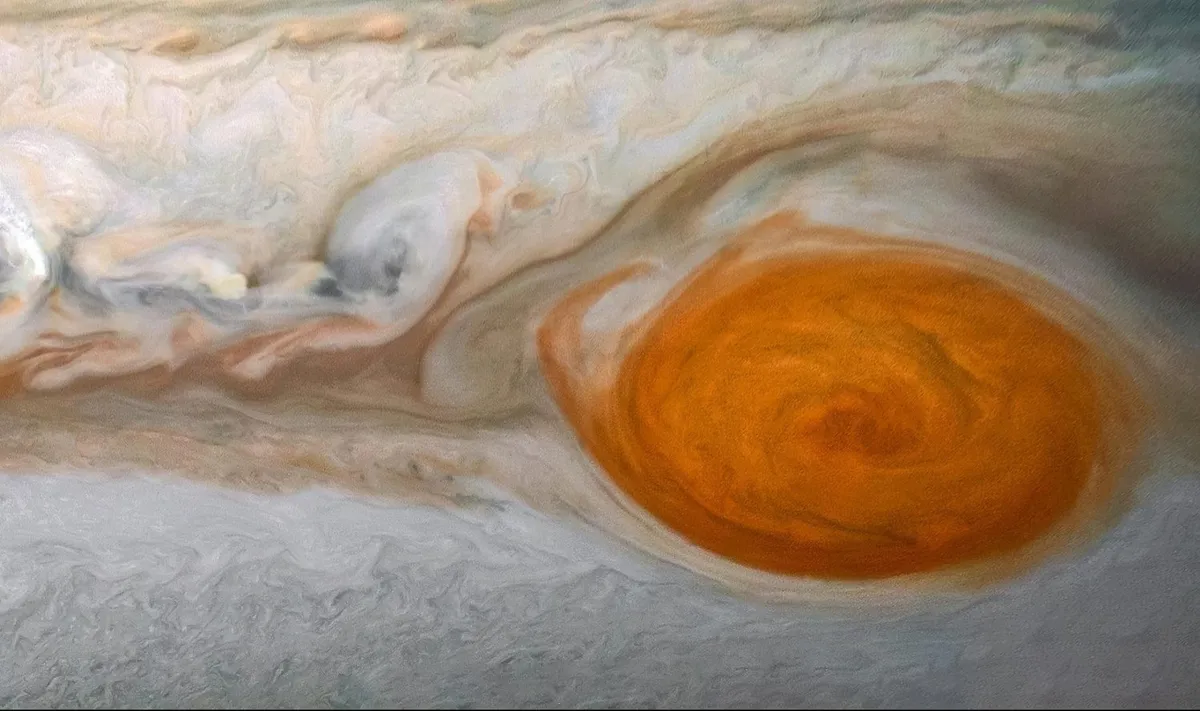Stuart Atkinson can still remember the first images from space he saw. It was the early seventies and NASA’s Apollo adventure was in full swing. He and his classmates had been gathered into the hall at their primary school in Cumbria and a bulky television set had been tuned in to the coverage of the US astronauts on the lunar surface.
“People in that room, other people got into football or sport, with me it was just straight away from day one I was into space,” he says.
It’s a similar story for Mick Hyde. Like Atkinson, it was the sight of our nearest neighbour – in his case, an astonishing oblique view of the crater Copernicus from the Lunar Orbiter 2 spacecraft – that he remembers particularly.
Read our image processing guides:
“I owned a small reflecting telescope at the time and loved observing the Moon,” says Hyde. “Copernicus was always a favourite of mine. To see it from this angle was truly amazing.”
Emily Lakdawalla had been interested in science her entire life and studied geology at college before moving into teaching; yet in the 1990s, the spectacular pictures returned by missions at Mars and Jupiter prompted a career change.
“It was when Galileo was sending back the first images of Jupiter’s moons,” says Lakdawalla.
“It suddenly occurred to me to ask whether I could study geology on planets other than Earth. I talked to my geology advisor in college and she said why yes as a matter of fact you can and I went to grad school to do it.”

Shared endeavours
What then, other than a passion for space, links these three together? The answer is that their interest in images from the cosmos goes far beyond just admiring them in books or online.
They’re part of a growing band of amateur astronomers, space enthusiasts and interested members of the public who are processing image data from missions exploring our Solar System and the Universe at large.
The result: astonishing pictures of worlds and landscapes that rival the works of even the greatest painters and photographers.
Spurred by those early views of Apollo, Atkinson developed a keen interest in astronomy.
But it was the landings of the Mars Exploration Rovers Spirit and Opportunity on the Red Planet in 2004 that threw him into the world of processing space images.
“That was the first time things were actually put out on the internet. Before then it was all quite a closed shop,” he recalls.
“I remember watching the landing of Spirit. I was on my Windows PC sitting at home watching on a 2x2-inch screen on dial up and it kept breaking up and going into this blaze of pixels then starting again.”
The view on his computer screen may have been shaky by today’s standards, then, but that early coverage nonetheless had a profound impact on Atkinson.
“Everything was online. All the photographs, the landings were live [and the] press conferences after that,” he says. “It was like being on Columbus’s ship with him going to America and seeing this new world for the first time.”
There has been no shortage of breathtaking imagery released in recent years by the teams working on space telescopes, planetary probes and rovers.
But it’s the chance to process and interpret the raw image data from these missions themselves that Atkinson and his colleagues revel in.
“I feel like I’m walking alongside that rover with my hand on her back seeing what
she sees, saying ‘look over there, look at that hill’,” he says.
Some people go for accuracy and balance. I just try and make pretty pictures. I try and make a picture that looks like how I imagine Mars would be if I went there.
Stuart Atkinson
That sense of discovery, and of gazing upon a previously unseen vista, is echoed by Lakdawalla, who works for the California-based Planetary Society.
“Most people don’t appreciate how much more data there is than gets publicly released by, say, JPL. That’s not because they’re hiding anything, it’s just that there’s only so many images that you can write captions for,” she says.
“It’s exactly like a museum has only one per cent of its collection on display and then it has this much deeper collection in its vaults. I like finding things that people haven’t really processed and appreciated before.”
Today a handful of – mainly NASA – missions offer a form of raw image data on their websites alongside the numerous polished images released officially by their science teams and parent space agencies.
“There are some missions that are releasing JPEG versions of all of their image data almost immediately to the web,” says Lakdawalla. “They include the Mars Exploration Rover Opportunity, Curiosity and Cassini as well as the Visual Monitoring Camera on Mars Express.”
Older NASA data, including images from past missions like Voyager and Galileo, is stored on a vast online repository known as the Planetary Data System.
Before embarking on processing image data from your favourite mission, do make sure you are aware of any rules governing its use.
“Any data produced by any American government agency is in the public domain,” says Lakdawalla. “So there are really no rules for what you can do with NASA images, you can do anything with them.
"ESA are different. In general they require attribution for images. So you can’t just slap an image on something and claim it as yours. You have to acknowledge ESA and the different institutions whose investigators worked on that image data.
"Recently ESA has been releasing images with Creative Commons licences to allow them to be shared on Wikipedia, but only for certain data sets.”
If you’ve taken pictures of the night sky before, the methods used to bring out details in professional space image data will probably seem quite familiar
“Some of the cameras that I use for imaging the Moon, planets and deep-sky objects are very similar to the ones used on remote spacecraft,” says Hyde, who is an accomplished amateur astrophotographer.
“Assembling large mosaics of the Moon or nebulae uses the same skills for processing spacecraft data.”

From bits to Bierstadt
Just as with astrophotography, you needn’t necessarily have expensive image processing software either.
“You can use GIMP,” says Lakdawalla. “You can use that to do almost all of the things you need to do.”
Typically, the raw image data is monochrome and may require stretching with the Levels tool to make the landscape or subject apparent on screen.
“If you want colour pictures you have to combine three images taken through different filters into colour,” explains Lakdawalla.
“That’s very easy for Mars rovers because the camera stays still as it takes the different pictures. But for Voyager and Cassini or Galileo, the spacecraft is moving between the pictures and so you often have to do resizing, stretching, rotation, other tricks that are more art than science in order to get the images to line up properly to make nice-looking colour pictures.”
Indeed what’s perhaps most interesting about the images produced by amateurs is that the same set of data may be processed in a number of different ways, with each person making their own artistic or technical decisions about how the picture should look.
“Some people go for accuracy and balance these Curves and Levels and all sorts,” says Atkinson. “I just try and make pretty pictures. I try and make a picture that looks like how I imagine Mars would be if I went there.
"I’m a big fan of people like Ansel Adams and Albert Bierstadt, these painters and photographers who took the landscapes of the American West and just made them look ‘wow’ gorgeous. I’m trying to do that in a little way with Mars.”
Building the picture
Others use the powerful image processing software available today to breathe new life into much older mission data.
Ted Stryk’s work on the Venera and Voyager data has produced exquisite new renditions of the pictures returned by these pioneering spacecraft.
“The Venera images are our only views from the surface of Venus,” says Stryk, a professor of philosophy at Roane State Community College in Tennessee. “Yet many of the versions shown look like bad scans and in some cases might even be photocopies.
"So I try to combine all the data available from each lander to make the best possible product. In the case of Voyager, my particular interest has been the moons of Uranus and Neptune. Given the low illumination and high speed of the spacecraft, many images are smeared, so I have worked to de-smear them.
"Also, many are poorly exposed and are somewhat noisy. I have worked on stacking all available images of a target from a given angle in order to cancel out as much of this as possible."
If you have a more analytical than artistic streak, you can use some sets of spacecraft image data to carry out your own simple scientific studies.
You often have to do resizing, stretching, rotation, other tricks that are more art than science to get the images to line up to make nice-looking colour pictures.
Emily Lakdawalla
"There’s a lot that people could do looking at, for instance, HiRISE data from Mars," says Lakdawalla.
"There is a lot of imagery from HiRISE [a camera on the Mars Reconnaissance Orbiter] that really hasn’t been looked at in very much detail."
Such analyses might involve scrutinising images for signs of changes on the Martian surface, such as the appearance of fresh impact craters, rockfalls or even clouds.
Today Atkinson is the one who’s inspiring the next generation of astronomers with the space images he processes.
"I tell kids in my talks, you can go online when you get home from my talk, you can see pictures tonight sat in your lounge from Mars, from the Moon, from Saturn, from asteroids just by clicking," he says.
"When I was growing up, you couldn’t do that."
His message to the mission scientists that have released their data, so that people like him can explore and enjoy it, is a simple one: "Thank you, really, for letting us join in with the adventure."
Data mine
Start your exploration of professional image data from outer space with these weblinks
1
Planetary Data System Imaging Node
The image archives, supporting data sets, software tools and tutorials for the digital collections from NASA’s planetary missions.
2
Mars Exploration Rover Opportunity raw images
The unprocessed image data from the five cameras on NASA’s Mars rover.
mars.nasa.gov/mer/gallery/all/opportunity.html
3
Mars Science Laboratory ‘Curiosity’ raw images
The unprocessed image data from the eight cameras on NASA’s latest Mars rover.
mars.jpl.nasa.gov/msl/multimedia/raw
4
Cassini spacecraft raw images
The archive for all raw image data from Cassini at Saturn.
saturn.jpl.nasa.gov/photos/raw
5
JunoCam raw images
Raw image data captured by NASA's Juno mission at Jupiter
www.missionjuno.swri.edu/junocam/processing/
This article originally appeared in the May 2015 issue of BBC Sky at Night Magazine.
